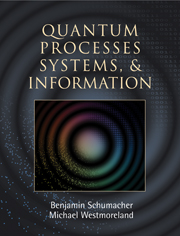Book contents
- Frontmatter
- Contents
- Preface
- 1 Bits and quanta
- 2 Qubits
- 3 States and observables
- 4 Distinguishability and information
- 5 Quantum dynamics
- 6 Entanglement
- 7 Information and ebits
- 8 Density operators
- 9 Open systems
- 10 A particle in space
- 11 Dynamics of a free particle
- 12 Spin and rotation
- 13 Ladder systems
- 14 Many particles
- 15 Stationary states in 1-D
- 16 Bound states in 3-D
- 17 Perturbation theory
- 18 Quantum information processing
- 19 Classical and quantum entropy
- 20 Error correction
- Appendix A Probability
- Appendix B Fourier facts
- Appendix C Gaussian functions
- Appendix D Generalized evolution
- Index
10 - A particle in space
Published online by Cambridge University Press: 05 June 2012
- Frontmatter
- Contents
- Preface
- 1 Bits and quanta
- 2 Qubits
- 3 States and observables
- 4 Distinguishability and information
- 5 Quantum dynamics
- 6 Entanglement
- 7 Information and ebits
- 8 Density operators
- 9 Open systems
- 10 A particle in space
- 11 Dynamics of a free particle
- 12 Spin and rotation
- 13 Ladder systems
- 14 Many particles
- 15 Stationary states in 1-D
- 16 Bound states in 3-D
- 17 Perturbation theory
- 18 Quantum information processing
- 19 Classical and quantum entropy
- 20 Error correction
- Appendix A Probability
- Appendix B Fourier facts
- Appendix C Gaussian functions
- Appendix D Generalized evolution
- Index
Summary
Continuous degrees of freedom
The quantum systems we have discussed so far have been described by finite-dimensional Hilbert spaces. Basic measurements on such systems have a finite number of possible outcomes, and a quantum state predicts a discrete probability distribution over these. Now we wish to extend our theory to handle systems with one or more continuous degrees of freedom, such as the position of a particle that can move in one dimension. This will require an extension of our theory to Hilbert spaces of infinite dimension, and to systems with continuous observables.
There is a philosophical issue here. How do we know that there really are infinitely many distinct locations for a particle? The short answer is, we don't. It might be that space itself is both discrete (at the tiniest scales) and bounded (at the largest), so that the number of possible locations of a particle is some very large but finite number. If this is the case, then the continuum model for space is nothing more than a convenient approximation. Infinity is just a simplified way of describing a quantity that is immense, but still finite.
In this section, we will adopt this view of infinity. We will imagine that any continuous variable is really an approximation of a “true” discrete variable. This idea will motivate the continuous quantities and operations that we need.
Information
- Type
- Chapter
- Information
- Quantum Processes Systems, and Information , pp. 202 - 223Publisher: Cambridge University PressPrint publication year: 2010
